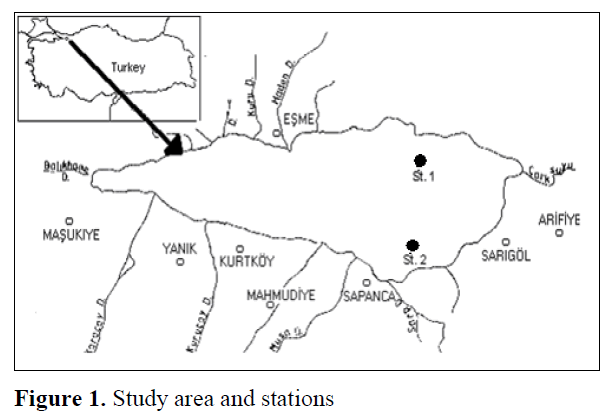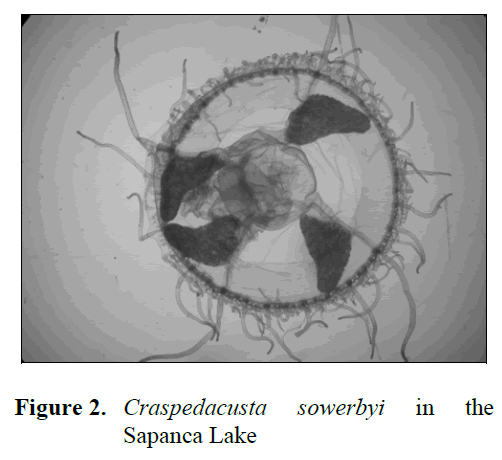Key words
Craspedacusta sowerbyi, fresh water medusa, Sapanca Lake, Turkey
Introduction
In recent times, Craspedacusta sowerbyi Lankester, 1880 (Cnidaria: Hydrozoa) has been found sporadically and often in large numbers in ponds, lakes, reservoirs and rivers in the north temperate regions of the world (Rayner, 1988). This freshwater planktonic medusa was first dis-covered in 1880 in Regent's Park, London, in a pond containing a water plant from Brazil (Payne, 1924). In following years, C. sowerbyi, has been registered in several European coun-tries: Italy, France, Sweden, Spain and recently Portugal (Seworby, 1941; Ferreira, 1985), 31 states of the USA specially eastern states (De Vries, 1992), Canada, Hawaii and Australia of the south (Thomas, 1950), the Islands of the Philippines, China, Japan, Asia Centrals and South America (Acker, 1976), as well as New Zealand (Didžiulis, 2006; Boothroyd et al., 2002)
In Turkey, Dumont (1994) mentioned that C. sowerbyi was observed two localities in Turkey: one in Istanbul (aquarium occurrences), the other in the Euphrates-Tigris region (probably Keban Reservoir). Bal?k et al. (2001) was also reported C. sowerbyi in Topçam Reservoir (Ayd?n, Tur-key). C. sowerbyi medusae occur sporadically within freshwaters and are thus generally ignored in the monitoring studies of water quality, which explains the lack of studies and the paucity of records. C. sowerbyi was observed in Sapanca Lake since the beginning of 1990’s but has re-ceived very little attention.
Materials and Methods
Sapanca Lake is located in the northwestern part of Turkey (Figure 1). Its surface area is 46.8 km2 and maximum depth is 55 m. The lake water is used as a source of drinking water by the city and district of Adapazar?, which has a population of more than 500000, and as a recreational area. The lake was classified oligotrophic till the end of 1990’s and has gradually changed to meso-tropy after that (Aykulu et al., 2006; Akcaalan et al., 2007).

Figure 1. Study area and stations
Samples were collected by both vertical tow-ing using a plankton net (50 μm mesh size, 0.25 m mouth diameter) from bottom to surface and using hand net from the surface water. Water temperature, pH and dissolved oxygen were measured by YSI 650 multiparameter.
Results and Discussion
Although C. sowerbyi has been observed in the lake for more than two decades, the mea-surements of individuals were done first time in the present study. The medusae were observed in the plankton of the lake between early August and late September. Samples were taken from two stations in the eastern part of the lake. Maximum depths of the stations were 20 m and 2 m at the first and second station, respectively. The mean temperature was 24.3 °C (± 1.5), pH was 9.1 and dissolved oxygen was recorded as 7.4 mg L-1. The mean water transparency was measured as 5.6 m.
C. sowerbyi was dispersed in most parts of the lake, but could not be observed in the western part which is shallow and occupied by dense ma-crophyte population. The minimum and maxi-mum umbrella diameter was 4 mm and 11.6 mm; number of tentacles ranges between 200 and 480 (Figure 2). The number of gonads present was 4 per medusa.

Figure 2. Craspedacusta sowerbyi in the Sapanca Lake
The growth and reproductive activity of C. sowerbyi generally take place in summer months in temperate regions and medusae are found in open water as a common feature (Boothroyd et al., 2002). The occurrence of C. sowerbyi in Sa-panca Lake is consistent with these findings. Ori-ginating from China, the medusae have a world-wide distribution, although it is impossible to find out how this happened and the way of intro-duction to the new localities (Fritz et al., 2009). Probably not the medusae but the tiny polyps could be transported by several ways, especially by ornamental, exotic aquatic plants, by aquatic animals or by bird’s feet (Didžiulis, 2006). The way of introduction of this species to Sapanca Lake is also unknown. However, it is possible that human activities caused its presence in the lake. In the last decades, some exotic fish species like Carassius gibelio (Bloch, 1782), Lepomis gibbosus (Linnaeus, 1758), even a couple of pi-ranha, which did not form a population luckily, have been found in the lake.
Although, more species of genus Craspeda-custa were described, only C. sowerbyi has a worldwide distribution. Possible reasons could be the several types of vegetative reproduction, suc-cessful long term survival and also the ability of producing a resting body in adverse conditions (Fritz et al., 2007). These features may facilitate its invasions in new localities and also enable to form a new population in different kind of water bodies, making this species a successful invader.
C. sowerbyi feeds mainly on zooplankton. Smith and Alexander (2008) claimed that the medusae could affect the zooplankton community and if there is a medusae-bloom, community structure can be altered, causing a significant change in food web of aquatic systems. Also, individuals may consume excess oxygen and so decreases the quality of environment fish live in and the drinkable water. For these reasons, a de-tailed study on C. sowerbyi population in Sa-panca Lake must be conducted.
Conclusion
In conclusion, C. sowerbyi was first record in Sapanca Lake in this study. It was seen in this fresh water lake between early August and late September, 2009 when the temperature increases. The lake water is used as a source of drinking water by the city and district of Adapazar?, and as a recreational area. For these reasons, a detailed study on C. sowerbyi population in Sapanca Lake must be conducted.
Acknowledgements
This study was supported by The Scientific and Technical Research Council of Turkey (107G261). We also thank to L. Köker and B. O?uz for their help in sampling.
817
References
- Al-Hazza, R., Hussein, A., (2003b.), Stickiness elimination of Himri (Barbusluteus, Heckel) Eggs. Turkish Journal of Fisheries and Aquatic Science, 3: 47-50.
- Al-Hazza, R., (2005), Some biological aspects of the HimriBarbel, Barbusluteus, in the intermediate reaches of the Euphrates river. Turkish Journal of Zoolgy, 29: 311-315.
- A.O.C.A. (1990), Official methods of analysis. Association of official analytical chemists. 15th edn. Virginia, USA.
- Azim, M.E., Wahab, M. A., Kamal, A.H.M., Zoarder, F.A., (2004), Feeding relations of Silver Barb Barbodesgonionotus (Bleeker) with Major Indian and Common Carp and its effect on fish production in a polyculture system. Journal of World Aquaculture Society, 35(1):100-108.
- Boyd, C.E., Tucker, C.S., (1998), Pond aquaculture water quality management. Kluwer Academic Publishers. USA.
- Da Silva, L.B., Barcellos, L.J.G., Quevedo, R.M., Souza, S.M.G., Kreutz, L.C., Ritter, F., Finco, J. A., Bedin, A.C., (2006), Alternative species for traditional carp polyculture in southern South America: Initial growing Period. Aquaculture, 255: 417-428.
- El-Sayed, A.F.M., (2002), Effects of stocking density and feeding levels on growth and feed efficiency of Nile Tilapia (Oreochromisniloticus L.) fry. Aquaculture Research, 33: 621-626.
- Epler, P., Sokolowskja-Mikolajczyk, M., Popek, W., Bieniarz, K., Kime, D.E., Bartel, R., (1996), Gonadal development and spawning of Barbussharpeyi, Barbusluteus and Mugilhishni in fresh and saltwater lakes in Iraq. Archives of Polish Fisheries, 4: 113-124.
- Epler, P., Bartel, R., Chyp, J., Szczerbowski, J.A., (2001), Diet of selected fish species from the Iraqi lakes Tharthar, Habbaniya and Razzazah. Archives of Polish Fisheries, 9: 211- 223.
- Gokcek, C.K., Akyurt, I., (2007), The effect of stocking density on yield, growth and feed efficiency of HimriBarbelBarbusluteus (Heckel,1843) nursed in cages. The Israeli Journal of Aquaculture, 59(2);99-103.
- Gokcek, C.K., Mazlum, Y., Akyurt, I., (2008), Effect of feeding frequency on the growth and survival of himribarbelBarbusluteus (Heckel, 1843), fry under laboratory conditions. Pakistan Journal of Nutrition, 7(1): 66- 69.
- Haque, S.M., Wahab, M.A., Wahid, M.I., Haq, M.S., (1998), Impacts of Thai silver barb (PuntiusgonionotusBlecker) inclusion in the polyculture of carps. Bangladesh Journal of Fisheries Research, 2: 15-22.
- Jena J.K., Ayyappan S., Aravindakshan P.K., Muduli, H.K., (2001), Comparative evaluation of growth, survival and production of carp species at different stocking densities under polyculture. Indian Journal of Fisheries, 48;17-25.
- Jena J.K., Ayyappan S., Aravindakshan P.K., Dash B., Singh S.K., Muduli, H.K., (2002a.), Evaluation of production performance in carp polyculture with different stocking densities and species combinations. Journal of Applied Ichthyology, 18:165-171.
- Jena J.K., Ayyappan S., Aravindakshan P.K., Muduli, H.K., (2002b.), Comparative evaluation of production performance in varied cropping patterns of carp polyculture system. Aquaculture, 207:49-64.
- Kaushik, S.J., (1995), Nutrient requirements, supply and utilization in the context of carp culture. Aquaculture, 129: 225–241.
- Kestmont, P. (1995), Different systems of carp production and their impacts on the environment. Aquaculture, 129: 347–372.
- Lutz, G.C., (2003), Polyculture: principles, practices, problems, and promises. Aquacultural Magazine (March/April).
- Naama, A.K., Muhsen, K.A., (1986), Feeding periodicities of the Mugilid Liza abu (Heckel) and Cyprinid Carasobarbusluteus (Heckel) from Al-Hammar Marsh, Southern Iraq. Indian Journal of Fisheries, 33(3): 347- 350.
- Szypula, J., Epler, P., Bartel, R., Szczerbowski, J.A., (2001), Age and growth of fish in lakes Tharthar, Razzazah, and Habbaniya. Archives of Polish Fisheries, 9: 185-197.








